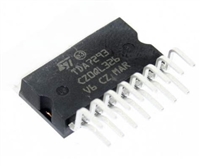ML6420
ALIASING: THE PROBLEM
Aliasing is a signal distorting process that occurs when an
analog signal is sampled. If the analog signal contains
frequencies greater than half of the sampling rate, those
frequencies will be altered and “folded back” in the
frequency domain. These frequencies represent a distortion
of the original signal as represented in the sampled domain,
and cannot be corrected after sampling.
Since they have flat amplitude and linear phase, they are
low distortion. And since the aliasing is removed at the
analog input to the ADC, the clock rates are minimized,
an expensive DSP half band filter is eliminated, and
significant power is conserved.
Oversampling vs Nyquist sampling
THE RESULT OF ALIASING IN A TV PICTURE
Clearly the purely analog monolithic solution versus the
analog/digital solution using DSP filtering are different
ways of solving the same problem. Other than costs
(purely analog is many times less expensive) there are no
real differences in performance for applications that
require flatness specs of ±0.5db to 4.5MHz for consumer
and pro-sumer video applications. The ML6420/ML6422
are also phase corrected for flat group delay, a feature not
found in typical low cost analog filters, and a
Aliasing causes several disturbing distortions to a picture.
Since the folded spectrum adds to the original spectrum, it
will sometimes be in phase, and sometimes out of phase
causing ripples in response that depend on the position of
the picture element relative to the clock. The net effect is
that picture elements, edges, highlights, and details will
“wink” in amplitude as they move across a picture if they
have high frequency content above the Nyquist frequency
of the sampler.
characteristic often associated with digital filters alone.
The following section highlights the importance of linear
phase response in video applications.
ANTI-ALIASING
TIME DOMAIN RESPONSE:
TRANSIENTS AND RINGING
Anti-aliasing reduces the bandwidth of the signal to a
value appropriate for the sample processing system. Some
detail information is lost, but only the information that
cannot be unambiguously displayed is removed. Assuming
that the passband contains the “real” picture information,
the only distortion that occurs is due to amplitude and
phase variations of the anti-aliasing filter in the passband.
The following section shows approaches using digital and
analog filters in an oversampled system, and a monolithic
analog filter as a lower cost alternative.
The phase response of filters is often ignored in
applications where time domain waveforms are not
relevant. But in video applications the time domain
waveform is the signal that is finally presented on the
screen to the viewer, and so time domain characteristics
such as pulse response symmetry, pre-shoot, over-shoot
and ringing are very important. Video applications are
very demanding in that they require both sharp cutoff
characteristics and linear phase. The application of DSP to
the problem is based on the linear phase characteristic of
a particular class of digital filters known as symmetrical
FIR filters. Use of these filters guarantees the best possible
time domain characteristics for a given amplitude
characteristic. In the analog domain phase linearity is not
automatic (except for special phase linear filters such as
Bessel or Thomson filters, both of which have inadequate
amplitude characteristics for most video anti-alias
applications) and it is often assumed that linear phase is
unachievable. This is not true. Similarly, in the digital
domain it is often assumed that sharp cutoff amplitude
characteristics can be achieved without overshoot and
ringing. This is also not true. Phase linear filters whether
digital or analog have symmetrical response to
OVERSAMPLING
Aliasing cannot be removed once it occurs, it must be
prevented at the signal sampler. Many current systems are
choosing to prevent aliasing by increasing the clock rate of
the sampler. This is known as “oversampling”. Doubling
the clock rate greatly reduces the burden on the analog
anti-alias filter, but the increased data rate greatly
increases the size, complexity and cost of the Digital
Signal Processing (DSP) circuitry. Since the higher clock
rate generates more samples than are necessary to
represent the desired passband content, a digital filter may
be used to decimate the signal back to a lower sample
rate, saving size, complexity and power in the
downstream circuitry. Since this digital filter itself is a
complex digital block, this method cannot be considered
the lowest cost approach to solving the anti-alias problem.
symmetrical inputs. High roll-off rate uncompensated
filters (whether analog or digital) have ringing and
overshoot. In the example below, the traditional 2T test
pulse is applied to a traditional, non-phase linear analog
filter, the ML6420 pure analog anti-alias filter (5.5MHz)
and the combined analog/digital filters (9.3MHz analog
filter and half-band digital filter.)
NYQUIST SAMPLING
In traditional systems, before the advent of higher speed
ADCs, anti-aliasing filters were designed in the analog
domain. The movement toward higher sampling rates was
an attempt to circumvent the difficult challenge of
designing a sharp roll-off, linear phase, non-distorting
analog filter. The ML6420 series of filters solve this
problem where it is best solved, in the analog domain.
Since they are monolithic, their application is simple.
As seen in Figure 19c, the ML6420 filters provide a time
domain response that is comparable to more complex and
expensive filters.
Typical Passive Filter
9






 高性能TDA7293音频功率放大器技术特性与应用分析
高性能TDA7293音频功率放大器技术特性与应用分析

 STM32H743技术深度剖析与应用案例探索
STM32H743技术深度剖析与应用案例探索

 LM321中文资料解析:引脚功能介绍、技术特点、技术特性分析
LM321中文资料解析:引脚功能介绍、技术特点、技术特性分析

 74HC14芯片资料介绍:性能特性分析、引脚介绍
74HC14芯片资料介绍:性能特性分析、引脚介绍
